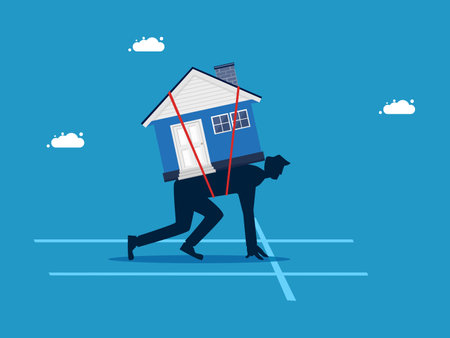Understanding Interest Rates
Interest rates play a crucial role in the U.S. housing market, especially for first-time homebuyers who are often navigating these financial concepts for the first time. At their core, interest rates represent the cost of borrowing money from a lender to purchase a home. When you take out a mortgage, the interest rate determines how much extra you will pay on top of the amount you borrow. Even small changes in rates can significantly impact your monthly payment and the overall cost of your home over time.
In the United States, mortgage interest rates are influenced by several factors. One of the primary drivers is the Federal Reserve, which sets the federal funds rate—the benchmark for many types of loans. When inflation rises or the economy grows quickly, the Fed may increase this rate to slow things down, which usually causes mortgage rates to rise as well. Conversely, during periods of economic slowdown or recession, the Fed may lower rates to encourage borrowing and stimulate activity in sectors like real estate.
Other factors that affect mortgage rates include bond market activity, investor demand for mortgage-backed securities, and broader economic indicators such as employment numbers and consumer confidence. Lenders also consider your personal financial situation—your credit score, income stability, and debt-to-income ratio—when offering you a specific rate. Understanding these dynamics is essential for first-time buyers because it helps you make informed decisions about when to enter the market and how to shop for a mortgage that fits your budget and long-term goals.
2. Why Interest Rates Matter for First-Time Homebuyers
For first-time homebuyers in the U.S., understanding interest rates is crucial when deciding when to purchase a home. Interest rates directly influence the size of your monthly mortgage payment, determine how much you can borrow, and ultimately impact whether your dream home is within reach. Even a small change in rates can make a significant difference in your overall affordability.
How Interest Rates Affect Your Mortgage Payment
Mortgage payments are made up of principal and interest. When interest rates go up, the portion of your payment that goes toward interest increases, meaning you pay more each month for the same loan amount. Conversely, lower rates mean lower monthly payments and possibly more room in your budget for other expenses or a larger home.
| Loan Amount | Interest Rate | Monthly Payment (30-Year Fixed) |
|---|---|---|
| $300,000 | 5% | $1,610 |
| $300,000 | 6% | $1,799 |
| $300,000 | 7% | $1,996 |
Loan Eligibility & Buying Power
Lenders use your income, debt-to-income ratio, and current interest rates to decide how much you can borrow. Higher rates often reduce your maximum loan amount because they raise monthly payments, making it harder to qualify for a loan at the price point you want. This can limit your options in competitive markets where every dollar counts.
Affordability: More Than Just Monthly Payments
Beyond just qualifying for a loan, interest rates affect the total cost of homeownership over time. A higher rate means you’ll pay tens of thousands more in interest across the life of your loan. For first-time buyers who may already be stretching their budgets, timing your purchase around favorable interest rates can be one of the smartest financial decisions you make.

3. The Relationship Between Interest Rates and Home Prices
When it comes to buying a home, especially for first-time buyers in the U.S., understanding how interest rates affect home prices is crucial. Typically, when mortgage interest rates go up, monthly payments become more expensive for buyers. As a result, some potential homeowners are priced out of the market or decide to wait, which can slow down buyer competition. In many cases, this cooling effect on demand can lead to a slowdown in home price growth or even a dip in prices in certain markets. On the flip side, when interest rates fall, borrowing becomes more affordable. Lower rates often bring more buyers into the market because monthly payments shrink, even if home prices remain high. This surge in demand can drive up home values and lead to bidding wars—especially in hot markets like Austin, Phoenix, or parts of California. It’s important to note that the relationship between interest rates and home prices isn’t always one-to-one; local economic factors, inventory levels, and overall demand also play a big role. For instance, while rising rates may cool off some areas, highly desirable neighborhoods with limited inventory might still see strong competition and steady price increases. First-time buyers should keep an eye on both national trends and local market conditions to make informed decisions about timing their purchase.
4. Timing Your Home Purchase: Pros and Cons of Waiting
Deciding when to buy your first home is a big deal, especially with interest rates constantly in flux. Should you wait for better rates or take the plunge now? Lets break down the risks and rewards of each approach so you can make an informed decision.
Pros of Waiting for Lower Interest Rates
- Potential Savings: If rates drop, your monthly payments could be significantly lower, saving thousands over the life of your loan.
- More Affordable Options: Lower rates might let you qualify for a larger loan, opening up more housing options.
- Improved Financial Stability: Extra time gives you a chance to save a bigger down payment or improve your credit score.
Cons of Waiting
- Rising Home Prices: In many U.S. markets, home prices continue to rise, which could offset any benefit from lower rates.
- Tougher Competition: If rates fall, more buyers may enter the market, increasing competition and possibly driving prices up further.
- No Guarantees: Theres no way to predict exactly when or if rates will drop; they could just as easily go higher.
Pros of Buying Now
- Building Equity Sooner: The earlier you buy, the sooner you start building equity and benefiting from potential home appreciation.
- Stable Payments: Locking in a fixed-rate mortgage protects you from future rate hikes and offers predictable monthly payments.
- Less Competition (in Some Markets): If rates are high, there may be fewer buyers shopping, giving you more negotiating power.
Cons of Buying Now
- Higher Monthly Payments: A higher interest rate means youll pay more each month and over the life of your loan.
- Less Room in Your Budget: Higher payments may stretch your finances or limit your other spending priorities.
Quick Comparison Table
| Buying Now | Waiting for Lower Rates | |
|---|---|---|
| Pace of Equity Building | Sooner | Delayed |
| Monthly Payment Amounts | Pays more if rates are high | Pays less if rates drop (uncertain) |
| Market Competition | P otentially less (if rates are high) | P otentially more (if rates drop) |
| Home Price Trends | Might buy before further increases | Might face higher prices later on |
| Financial Preparation Time | Sooner purchase, less prep time | More time to save/improve credit |
| Certain Outcome? | Certain terms at purchase time | No guarantee rates will drop |
Practical Considerations for First-Time Buyers
If youre on the fence, think about your personal situation—job stability, family needs, and how long you plan to stay in one place. Sometimes waiting makes sense, but sometimes acting now is best. Weigh these factors carefully to make the move thats right for you.
5. Tips for Navigating the Current Mortgage Climate
As a first-time homebuyer, understanding how to secure the best mortgage is more important than ever in today’s fluctuating interest rate environment. The right strategy can save you thousands over the life of your loan and help you achieve long-term financial stability.
Build a Strong Credit Profile
Your credit score plays a major role in the interest rate lenders offer you. Start by checking your credit report for errors, paying off outstanding debts, and making all payments on time. Even small improvements in your score can significantly impact your loan terms and monthly payments.
Shop Around for Lenders
Don’t settle for the first mortgage offer you receive. Compare rates from multiple lenders—including banks, credit unions, and online mortgage companies—to find the most competitive terms. Ask about lender fees, points, and options like rate locks to protect yourself from sudden market changes.
Consider Different Loan Products
Familiarize yourself with various loan types such as fixed-rate, adjustable-rate mortgages (ARMs), FHA loans, and VA loans if eligible. Each has unique advantages depending on how long you plan to stay in the home and your risk tolerance for future rate changes.
Prepare for Rate Fluctuations
If you’re worried about rates rising before you close, talk to your lender about locking in a rate or exploring float-down options that let you take advantage of drops before closing. Stay informed about Federal Reserve decisions and market trends so you can time your application strategically.
Create a Realistic Budget
Interest rates directly affect your monthly payment. Use online calculators to estimate affordability under different scenarios and factor in property taxes, insurance, and maintenance costs. Having a clear budget helps you avoid overextending yourself even if rates shift unexpectedly.
Work with Professionals
A local real estate agent and a knowledgeable mortgage broker can provide valuable insights into current market conditions and guide you through paperwork, negotiations, and timing considerations specific to your area. Their expertise can be crucial in helping you make confident decisions as a first-time buyer.
6. Resources for First-Time Homebuyers
Navigating the homebuying process as a first-time buyer in the U.S.—especially when interest rates are fluctuating—can be overwhelming. Fortunately, there are several reputable organizations and resources dedicated to helping you make informed decisions, understand mortgage options, and time your purchase effectively. Here is a list of trustworthy U.S.-based resources that provide guidance, education, and support for first-time homebuyers:
U.S. Department of Housing and Urban Development (HUD)
HUD offers comprehensive information on buying a home, including how interest rates affect affordability. Their website includes guides, calculators, and a directory of HUD-approved housing counseling agencies nationwide.
Consumer Financial Protection Bureau (CFPB)
The CFPB provides clear explanations of mortgages, interest rates, and loan options through their “Buying a House” toolkit. This resource helps buyers compare offers and understand the impact of rate changes.
National Association of Realtors® (NAR)
NAR offers market reports, buyer tips, and connects you with local realtors who understand current market trends and can advise on timing your purchase amid changing rates.
Fannie Mae HomeView™
This free online course from Fannie Mae educates first-time buyers about the homebuying process, credit requirements, mortgage products, and how interest rates influence monthly payments.
NeighborWorks America
A nonprofit organization offering local workshops, homebuyer education classes, and personalized counseling. They help buyers assess affordability based on current interest rates and connect them to down payment assistance programs.
State Housing Finance Agencies (HFAs)
Every state has its own HFA providing special programs for first-time buyers—including low-interest loans and grants. Check your states HFA website for localized resources that reflect current market conditions.
Utilizing these trusted resources will empower you to make confident decisions as you navigate the complexities of purchasing your first home—no matter where interest rates stand.


